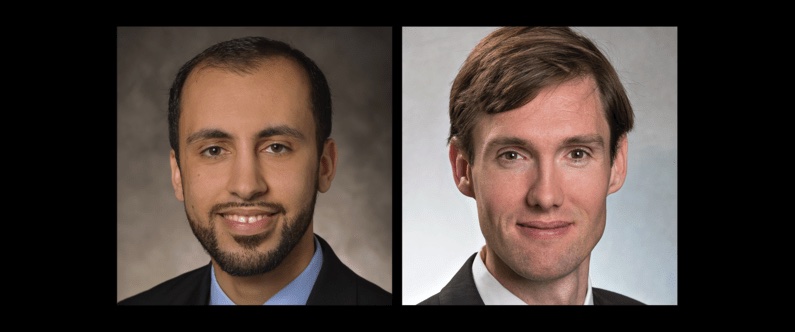Two experts speak at WCM-Q Grand Rounds
 WCM-Q alumnus Dr. Essa Abuhelaiqa, now a nephrology and transplant nephrology consultant at HMC, and Dr. Adam Tenforde of Harvard Medical School and Spaulding Rehabilitation Hospital in Boston.
WCM-Q alumnus Dr. Essa Abuhelaiqa, now a nephrology and transplant nephrology consultant at HMC, and Dr. Adam Tenforde of Harvard Medical School and Spaulding Rehabilitation Hospital in Boston.
Two leading experts spoke at Weill Cornell Medicine-Qatar’s (WCM-Q) Grand Rounds to discuss innovations in kidney transplantation and the use of shockwave therapy to manage musculoskeletal injuries in athletes.
WCM-Q alumnus Dr. Essa Abuhelaiqa, now a nephrology and transplant nephrology consultant at Hamad Medical Corporation, gave a presentation on the evolution of kidney transplant techniques, and strategies to expand the pool of kidney donors. He is also program director of the nephrology fellowship program and associate program director of the internal medicine residency program at HMC, and assistant professor of clinical medicine at WCM-Q.
Dr. Abuhelaiqa, who graduated from WCM-Q in 2011, explained that the one-year allograft survival rates for kidney transplants improved from less than 50 percent in the 1960s to over 90 percent today. Similarly, the rates of acute rejection of the transplanted organ dropped from over 80 percent to around 10 percent over the same period. These improvements are largely the result of the development of drug therapies for managing the body’s immune response, he said.
While the improving success of kidney transplants is good news, the number of kidneys required still vastly outstrips the supply, leading to many premature deaths each year. One successful innovation is a pair exchange model, whereby donors who are not a match for their loved-one are tested against other donors in the same position until a two-way match is found. It is also possible to establish longer chains of multiple couples, effectively creating a universally beneficial network of exchange that maximizes the chances of finding positive matches. The success rates of these chains can be dramatically boosted by bringing an unpaired altruistic donor into the group, said Dr. Abuhelaiqa.
Other ways to increase the number of donated kidneys include government programs that make it easy to opt-in for organ donation, nationwide publicity campaigns, and opt-out programs, where culturally appropriate, he said.
In a separate webinar, Dr. Adam Tenforde, associate professor at Harvard Medical School and director of shockwave and running medicine at Spaulding Rehabilitation Hospital in Boston, gave a presentation on the current evidence supporting the use of shockwave therapy in the management of musculoskeletal conditions. The presentation, titled, ‘Advances in Shockwave for Management of Musculoskeletal Injuries in Athletes,’ also explained how to apply knowledge of the technique in clinical practice.
Dr. Tenforde reviewed how musculoskeletal conditions are common among athletes, are often difficult to treat and recur frequently. Shockwave therapy, which directs low-energy acoustic waves to injured tissues to stimulate the body’s natural healing processes and break up scar tissue, is an attractive treatment modality because it is non-invasive, can be performed in outpatient settings, and has evidence from research studies to support its use. While early shockwave therapy devices were large, required use of nerve blocks, and often recommended immobilization, current devices are the size of a desktop computer, highly mobile and do not have the same need for nerve blocks or prolonged immobilization. The therapy has proven effective as a treatment for many conditions, including Achilles tendinopathy, proximal hamstring tendinopathy, greater trochanteric pain syndrome (which affects the hip, thigh, and/or buttock), tibialis posterior tendinopathy, medial tibial stress syndrome, and plantar fasciitis, among others.
Both lectures were delivered as live webinars and were accredited locally by the Ministry of Public Health’s Department of Healthcare Professions Accreditation Section and internationally by the Accreditation Council for Continuing Medical Education (ACCME).